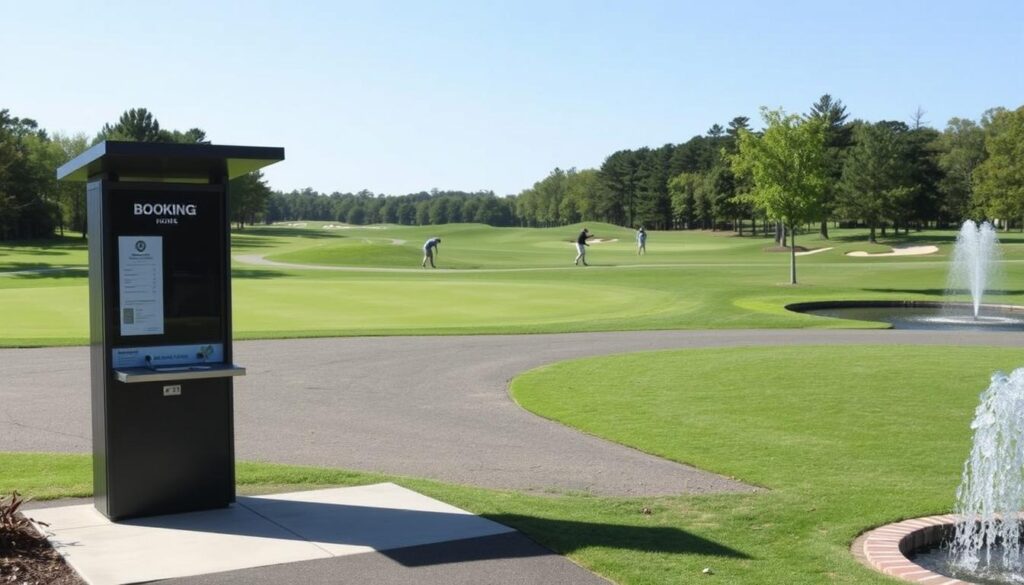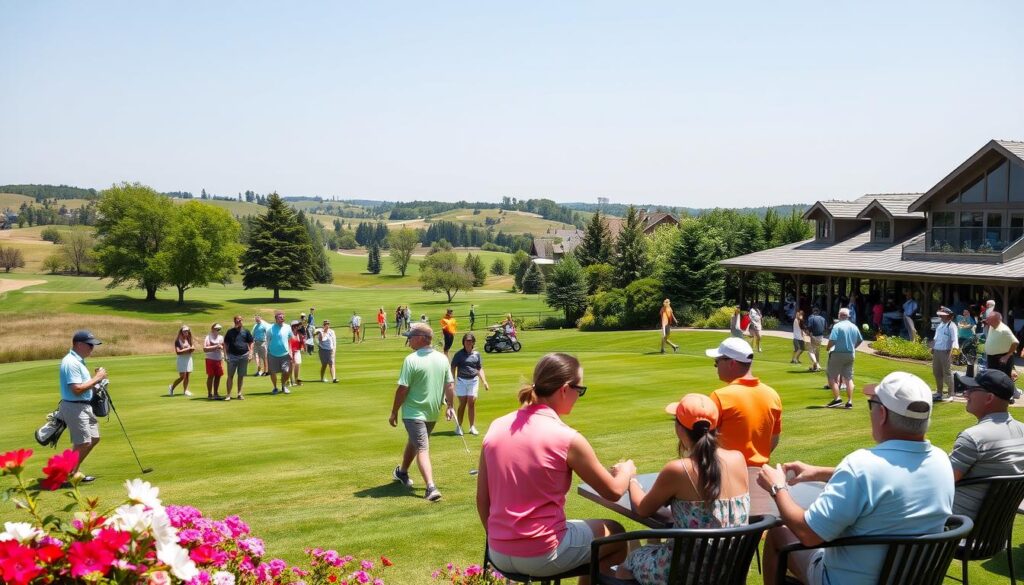In northern and central New Jersey, only a few golf courses offer the semi-private option. This shows how special semi-private golf courses are. They mix the best of public and private golfing.
Semi-private golf courses are unique. They offer exclusive memberships with extra benefits but are still open to everyone. These courses have top-notch facilities and well-kept fairways, similar to private clubs, but at a lower cost.
At these courses, members get special perks like early tee times and lower green fees. Non-members can also play and enjoy the facilities. This way, golf lovers can have a great experience without the high cost of private clubs.
Semi-private courses are known for their excellent maintenance. They have better dining, practice, and lesson facilities. This makes for a better golfing experience. Yet, they welcome all golfers, whether they’re members or not.
Key Takeaways
- Semi-private courses offer memberships and public access
- Members get priority tee times and reduced green fees
- Course quality is comparable to private clubs
- Better maintained than typical public courses
- Amenities include improved dining and practice facilities
- More accessible than private clubs, but pricier than public courses
Table of Contents
- 1 Understanding Golf Course Classifications
- 2 The Hybrid Nature of Semi-Private Golf Courses
- 3 Accessibility and Membership Options
- 4 Course Maintenance and Quality
- 5 Green Fees and Pricing Structure
- 6 Amenities at Semi-Private Golf Courses
- 7 Booking Tee Times: Members vs. Non-Members
- 8 The Social Aspect of Semi-Private Clubs
- 9 Comparing Semi-Private to Public Courses
- 10 Comparing Semi-Private to Private Courses
- 11 Advantages of Semi-Private Golf Courses
- 12 Disadvantages of Semi-Private Golf Courses
- 13 Considerations Before Joining a Semi-Private Club
- 14 Case Studies: Successful Semi-Private Golf Courses
Understanding Golf Course Classifications

Golf courses vary, each offering a unique experience. Your choice depends on your budget, how often you play, and what amenities you want. Let’s examine the main types to help you find your perfect match.
Public Courses
Public golf courses welcome everyone. They’re affordable and perfect for casual players. You can wear jeans and tank tops, and music is usually allowed, making it a relaxed place to play.
Private Courses
Private golf clubs offer exclusivity and top-notch facilities. Members get priority tee times and enjoy less crowded courses. These clubs invest in maintenance, ensuring great playing conditions. They also host social events, creating a close community.
Semi-Private Courses
Semi-private golf courses offer a mix of public access and membership benefits. They provide better amenities than public courses but cost less than private clubs. Members enjoy perks like free rounds and cart use.
| Course Type | Green Fees | Tee Times | Amenities |
|---|---|---|---|
| Public | $30-$100 | Open booking | Basic facilities |
| Private | Membership fee | Priority for members | Luxurious clubhouse, pro shop |
| Semi-Private | $50-$150 | Priority for members, open to public | Practice areas, dining options |
Your ideal course depends on your golfing goals, budget, and social preferences. Think about these factors when deciding between public, private, and semi-private courses.
The Hybrid Nature of Semi-Private Golf Courses

Semi-private golf courses are a mix of public and private. They let everyone play while offering special perks to members. This model suits both casual and serious golfers.
These courses have great grounds and facilities. You’ll find practice areas, lessons, and dining. The quality is high, but the cost is lower than private clubs.
| Day | Public Access | Member Access | Green Fees (Public) | Green Fees (Members) |
|---|---|---|---|---|
| Tuesday-Thursday | Yes | Yes | $25 (walking), $35 (riding) | $15 (walking), $25 (riding) |
| Friday-Sunday | Limited | Yes | $35 (walking), $45 (riding) | $20 (walking), $30 (riding) |
| Monday | No | Yes | N/A | $10 (walking), $20 (riding) |
By mixing membership fees with public green fees, semi-private courses stay top-notch. Public players get to enjoy great courses. Members get perks like early tee times and lower rates.
Accessibility and Membership Options

Semi-private golf courses offer a great mix. They let the public play while giving members special perks. This setup meets different golfing needs and budgets.
Public Access
Non-members can play by paying a fee. This makes it easy for those who play less often to enjoy top-notch courses. Dallas has many semi-private courses for players to choose from.
Membership Benefits
Being a member brings many perks. You get lower green fees, extra amenities, and sometimes discounts on food and drinks. The cost to join varies, with fees from $1,000 to $25,000 and annual dues from $1,000 to $5,000.
Priority Tee Times
One big plus of membership is getting tee times first. This means you can play when you want. It’s great for those who love golf and want to play often.
| Membership Type | Initiation Fee | Annual Dues | Tee Time Priority |
|---|---|---|---|
| Family | $5,000 – $25,000 | $3,000 – $5,000 | Highest |
| Individual | $2,500 – $15,000 | $2,000 – $4,000 | High |
| Corporate | $10,000 – $50,000 | $5,000 – $10,000 | Medium |
| Non-Resident | $1,000 – $5,000 | $1,000 – $2,000 | Low |
Course Maintenance and Quality

Semi-private golf courses are known for their top-notch conditions. They spend a lot on keeping the fairways and greens in great shape. This offers a high-quality experience, without the cost of private clubs.
The higher prices at these courses help pay for better upkeep. Groundskeepers work hard to make sure the fairways are firm and the greens are fast. Over 52% of golfers say having great bunkers is crucial to a good game, and semi-private courses meet this need.
Every day, maintenance teams fix ball marks, rake bunkers, and repair divots. They use special chemicals to keep the grass healthy. This focus on detail means the course is always ready for play, with consistent slope, speed, and putting surfaces.
| Maintenance Aspect | Semi-Private Course | Public Course |
|---|---|---|
| Mowing Frequency | Daily | 2-3 times per week |
| Irrigation Management | Advanced systems with moisture sensors | Basic irrigation systems |
| Bunker Maintenance | Daily raking and edging | Weekly maintenance |
| Green Speed (Stimpmeter) | 9-11 feet | 7-9 feet |
The dedication to excellence in maintenance at semi-private courses means better playing conditions all season. This level of care makes every game special and memorable.
Green Fees and Pricing Structure

Golf course pricing varies a lot across semi-private clubs. These courses aim to be both accessible and high-quality. They have a special fee structure for both members and non-members.
Member Rates
Members get big discounts on green fees. Annual dues are between $1,000 and $5,000. This gives them lower rates all year.
Some clubs let members play as much as they want for a fixed fee. Others charge per round but at a lower price.
Non-Member Rates
Non-members pay more for green fees. But they still pay less than private club guests. Prices are between $50 and $200 per round.
These prices depend on the course’s fame and where it’s located.
Seasonal Variations
Seasonal green fees are common in golf. Rates can be 30-50% higher in summer or busy times. Many courses have twilight rates for late afternoon play.
This is a cheaper option for both members and non-members.
| Season | Member Rate | Non-Member Rate |
|---|---|---|
| Peak (Summer) | $60-$100 | $100-$200 |
| Off-Peak (Winter) | $40-$70 | $70-$140 |
| Twilight | $30-$50 | $50-$100 |
This flexible pricing lets semi-private courses keep up quality while being open to more golfers. With discounts for members and different rates, these clubs attract both serious golfers and casual players.
Amenities at Semi-Private Golf Courses

Semi-private golf courses have many amenities like private clubs. They welcome both members and public players. This offers a top-notch experience without being exclusive.
Practice areas are an important feature. You’ll find great driving ranges, putting greens, and chipping areas. These spots let you practice before your game or work on your skills.
Clubhouse amenities are also a big plus. Many semi-private courses have well-stocked pro shops, comfy locker rooms, and social areas. You can grab a bite at the restaurant or unwind at the bar after playing.
Some semi-private courses offer more than just golf. You might find tennis courts or swimming pools, like the variety found in Italy. These extras add to the member experience, making it more relaxed than private clubs.
| Amenity | Availability | Member Perks |
|---|---|---|
| Driving Range | Year-round | Discounted buckets |
| Pro Shop | Daily | Member pricing |
| Restaurant | Lunch and dinner | Priority seating |
| Locker Rooms | Course hours | Permanent lockers |
While not as extensive as private clubs, semi-private courses offer great quality and variety. They’re perfect for golfers wanting a premium experience without the full private club commitment.
Booking Tee Times: Members vs. Non-Members

At semi-private golf courses, tee time reservations differ for members and non-members. Members get priority, often booking prime slots easily. They can reserve tee times well ahead, helping them plan their games better.
Non-members, though welcome, face more challenges. They have shorter booking windows and may find fewer tee times. This system helps members get the most from their investment while still letting others play.
Many semi-private courses use online booking systems that follow these rules. This makes booking tee times easier for everyone. Some courses even set aside certain times just for members, adding more value to their membership.
| Golfer Type | Booking Window | Priority Level |
|---|---|---|
| Members | 14 days in advance | High |
| Non-Members | 7 days in advance | Low |
Thinking about joining a semi-private club? Remember, getting tee times early is a big plus. It can greatly affect how often and when you play, especially in busy seasons. Gulf Shores, Alabama has many semi-private courses with different booking rules, for both members and visitors.
The Social Aspect of Semi-Private Clubs

Semi-private clubs mix social golfing with community. They offer many golf events for members and guests. This makes them welcoming to all golfers.
Member Events
These clubs have special events all year. From holiday parties to golf outings, they help members make friends. It creates a close golfing community.
Tournaments
Competitive events are important to the success of semi-private clubs. They suit all skill levels. Some clubs even let non-members join in.
Casual Play Opportunities
There’s always time for casual golf. Members can play with friends or join leagues. This makes semi-private clubs great for many golfers.
| Event Type | Frequency | Participation Rate |
|---|---|---|
| Member-Only Tournaments | Monthly | 65% |
| Open Tournaments | Quarterly | 80% |
| Social Mixers | Bi-weekly | 55% |
More women are joining golf clubs, up 6% since 2011. Clubs are making their events more welcoming. This change makes semi-private clubs a great choice for a balanced golf life.
Comparing Semi-Private to Public Courses

Golf course comparison shows big differences between semi-private and public courses. Semi-private clubs mix exclusivity with openness, finding a middle ground in the golf world.
When looking at public vs semi-private courses, quality stands out. Semi-private courses have better fairways and greens, giving a top-notch playing experience. They also focus on looks and design, making the game more enjoyable to watch.
Public courses welcome all, from new players to pros. They’re affordable and flexible, making golf fun for many. Semi-private courses, on the other hand, offer a more upscale feel with fewer people and better amenities.
Green fees vary between the two. Park City, Utah shows the range of golf experiences, from public to semi-private.
| Feature | Public Courses | Semi-Private Courses |
|---|---|---|
| Green Fees | Lower, $30-$80 | Higher, $60-$150 |
| Maintenance | Good | Excellent |
| Crowding | Often busy | Less crowded |
| Amenities | Basic | Enhanced |
| Tee Time Availability | Open to all | Priority for members |
Choosing between public and semi-private courses depends on your goals, budget, and what you want from golf. Each type has its own benefits, catering to different tastes in the golf world.
Comparing Semi-Private to Private Courses

Semi-private golf courses mix easy access with a touch of exclusivity. They find a balance between public and private clubs. Both offer great golfing experiences but in different ways.
Private clubs offer unmatched golf course exclusivity. Members get unlimited access, personal service, and fancy amenities. Semi-private courses, on the other hand, welcome both members and the public. This creates a diverse golfing community.
Membership costs differ a lot between these two. Private club fees can be from $400 to $125,000 a year. Semi-private courses have lower fees and dues. This shows the difference in exclusivity and perks.
Semi-private courses have a more laid-back vibe than private clubs. You’ll see both casual and serious golfers, making it a friendly place. Private clubs, however, have a more formal feel, aiming at a certain crowd.
| Feature | Semi-Private Courses | Private Courses |
|---|---|---|
| Access | Members and public | Members only |
| Membership Costs | Lower | Higher |
| Atmosphere | Relaxed | Formal |
| Amenities | Standard | Luxurious |
| Tee Time Availability | Good | Excellent |
When looking at private clubs, remember semi-private courses offer quality and flexibility at a lower cost. Your choice depends on what you value most in golf and your budget.
Advantages of Semi-Private Golf Courses

Semi-private golf courses offer a special mix of benefits for players and owners. They balance being open to many with a touch of exclusivity. This makes them appealing to a wide range of golf fans.
For golfers
These courses have many perks for players. You get to use top-notch facilities without the high costs of private clubs. The greens and fairways are as good as those in exclusive clubs.
Members get early tee times and lower green fees. Even non-members can enjoy the course’s quality.
For course owners
Owners of semi-private courses gain a lot. They get a steady income from memberships and also attract public play. This mix of income helps keep the course in great shape.
| Aspect | Semi-Private Course | Public Course | Private Course |
|---|---|---|---|
| Accessibility | Open to public with member privileges | Open to all | Members only |
| Green Fees | Moderate | Low to moderate | High (included in membership) |
| Maintenance | High quality | Variable | Excellent |
| Amenities | Good to excellent | Basic to good | Excellent |
Semi-private courses are great for those who want quality golf without spending a lot. For top golfing experiences, Atlantic City has some of the semi-private courses around.
Disadvantages of Semi-Private Golf Courses

Semi-private golf courses offer unique experiences, but they come with drawbacks for both golfers and course owners. Understanding these challenges helps you make informed decisions about playing or managing such facilities.
For Golfers
Golf course challenges at semi-private clubs can impact your game. During peak hours, you might face crowded fairways and slower play. Non-members often encounter higher green fees and limited tee time availability. This can make it tough to plan your rounds and enjoy a seamless golfing experience.
For Course Owners
Course management issues are a constant concern for semi-private club owners. Balancing member satisfaction with public access is tricky. Owners must navigate membership limitations while keeping the course open to non-members. This juggling act can lead to tension between different player groups.
Financial constraints pose another hurdle. Semi-private courses may not generate as much revenue as fully private clubs. This can limit investments in course improvements or expansions, potentially affecting the overall quality of the facility.
| Aspect | Disadvantage |
|---|---|
| Tee Times | Limited availability for non-members |
| Green Fees | Higher rates for public players |
| Course Traffic | Busier than private clubs |
| Revenue | Lower than fully private clubs |
Considerations Before Joining a Semi-Private Club

Thinking about joining a golf club is a big decision. There are many things to think about when choosing a semi-private club. Let’s look at some important points to consider before you decide.
Financial Commitment
First, think about the money involved. Look at the initiation fees, annual dues, and any extra costs. Compare these to what it costs to play as a non-member. To figure out the cost per round, divide the total membership costs by the number of rounds you plan to play each year.
Playing Frequency
Think about how often you’ll play golf. Studies say playing at least 20 rounds a year can save money. If you play less, joining might not be worth it financially.
Long-Term Goals
Think about what you want from golf. Do you want to compete or just enjoy the game? Or maybe you’re looking for a place to meet friends? Some people join for the social scene, while others value the course and practice areas.
| Factor | Importance |
|---|---|
| Course Condition | High |
| Practice Facilities | Medium |
| Social Activities | Varies |
| Proximity to Home | High |
| Pace of Play | Medium |
Also, think about the club’s amenities, location, and vibe. Many like clubs close to home and with quick play. Clubs with family-friendly features like dining and sports facilities are also popular. Your choice should match your lifestyle and what you enjoy about golf.
Case Studies: Successful Semi-Private Golf Courses
Semi-private golf courses have shown their value in the golf world. The Compass Pointe Golf Club in Leland, North Carolina, is a great example. They managed their course well by starting construction when sales were good. This strategy helped them grow, even in winter.
The Camelback Golf Club in Scottsdale, Arizona, also did well after a big renovation. Their income went up, showing that investing in quality works. Bentwater Yacht & Country Club in Montgomery, Texas, made sure all residents were members. This move helped their golf community thrive.
The Shangri-La Golf in Monkey Island, Oklahoma, made a smart choice by reducing from 36 to 27 holes. This led to a huge jump in memberships, from 87 to 500. These stories show how semi-private courses can succeed with the right planning.

